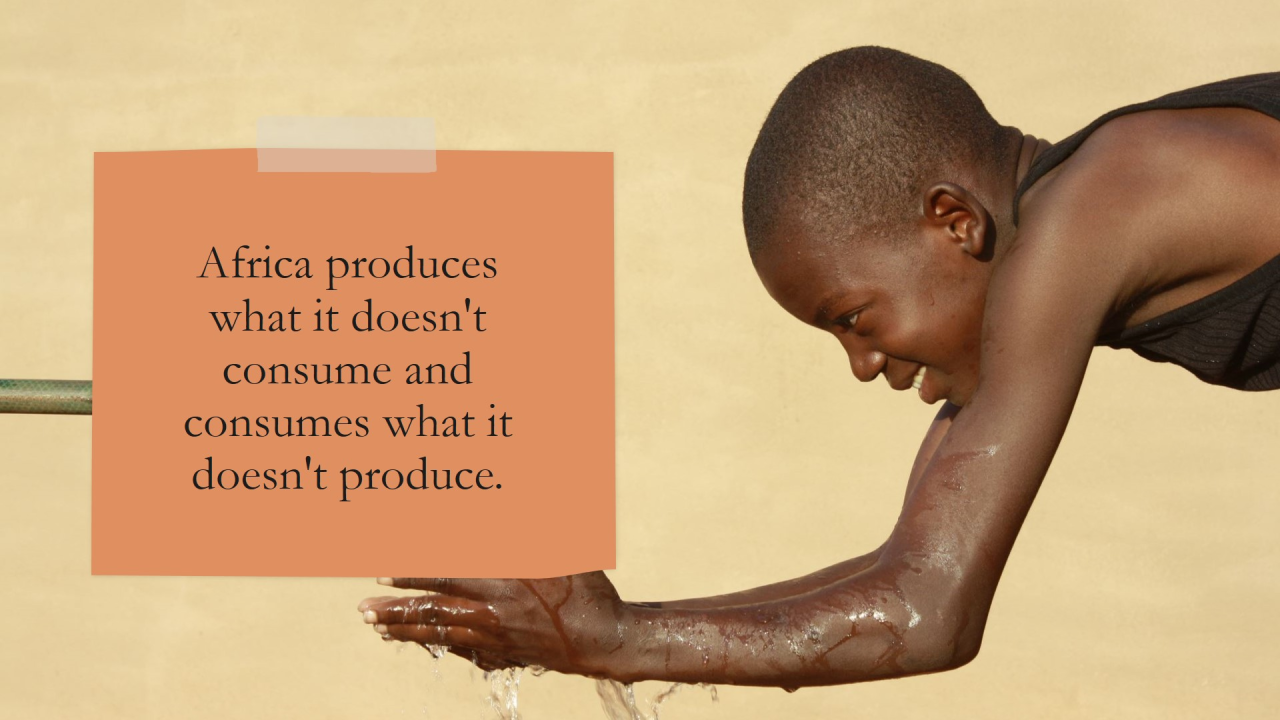Africa produces what it doesn’t consume and consumes what it doesn’t produce.

Africa’s agricultural landscape presents a striking paradox: the continent is rich in natural resources and agricultural potential, yet it produces what it does not consume and consumes what it does not produce. This dissonance has profound implications for food security, economic stability, and the overall well-being of its populations. Understanding the underlying causes of this phenomenon is essential for developing sustainable solutions that align production with consumption.
Historical Context
The roots of Africa’s agricultural challenges can be traced back to colonialism, which disrupted traditional farming practices and prioritised cash crops for export over local food production. This historical legacy has continued to shape agricultural policies, leading many countries to focus on commodities such as cocoa, coffee, and cotton while neglecting staple crops necessary for local diets. As a result, Africa has become increasingly dependent on food imports, despite having vast arable land and favourable climates.
Current Production Trends
Recent research underscores the ongoing struggle for self-sufficiency in Africa. A 2022 report by the Food and Agriculture Organisation (FAO) highlighted that many African countries are experiencing declining self-sufficiency ratios (SSR), indicating a growing gap between food production and consumption. The report notes that demographic pressures, such as rapid population growth, have outpaced agricultural productivity, exacerbating food insecurity across the continent.
According to a study published in VoxDev in March 2024, agricultural productivity in Africa has stagnated significantly. The report reveals that between 2010 and 2021, only 14 out of 48 African countries registered positive growth in total factor productivity (TFP), which measures the efficiency of all inputs used in agricultural production. This stagnation limits the ability of African nations to meet their food needs while relying heavily on imports for staples like rice and wheat.
Factors Influencing Consumption Patterns
Several interrelated factors contribute to Africa’s paradoxical production and consumption patterns:
- Economic Policies: Many African governments prioritise cash crop exports due to international market demand, diverting resources from food production aimed at local consumption. This focus on exports has left many countries vulnerable to global market fluctuations.
- Urbanisation: Rapid urbanisation has led to changes in dietary preferences, with urban populations increasingly consuming processed foods and imported goods rather than locally produced staples. This shift is often driven by perceptions of status associated with Western dietary habits.
- Infrastructure Challenges: Poor infrastructure hampers the distribution of locally produced food. Inadequate roads, storage facilities, and market access lead to high post-harvest losses, preventing farmers from reaching consumers effectively.
- Climate Change: Environmental challenges such as droughts and changing weather patterns have further strained agricultural output. The vulnerability of African agriculture to climate variability makes it difficult for farmers to maintain consistent production levels.
- Technological Stagnation: The lack of access to modern agricultural technologies has hindered productivity improvements. A 2023 study found that African farmers face numerous constraints—including limited access to credit, knowledge gaps, and inadequate market information—that prevent them from adopting innovative practices that could enhance yields.
The Way Forward
Addressing the imbalance between production and consumption requires a multifaceted approach:
Investment in Local Agriculture: Governments must prioritise investments in sustainable agriculture that focus on enhancing local food production rather than solely catering to export markets.
Improving Infrastructure: Enhancing transportation networks and storage facilities will help reduce post-harvest losses and ensure that locally produced food reaches consumers.
Promoting Agroecological Practices: Emphasising agroecological farming methods can improve food security while preserving local ecosystems. Research by the Alliance for Food Sovereignty in Africa advocates for investing in indigenous knowledge systems that promote sustainable farming practices.
Encouraging Local Consumption: Policies that promote the consumption of locally produced foods can help strengthen food security while supporting local economies.
Conclusion
The paradox of Africa producing what it does not consume while consuming what it does not produce highlights systemic issues rooted in historical exploitation, economic policies, and environmental challenges. By addressing these underlying factors through targeted investments and policy reforms, Africa can work towards achieving greater self-sufficiency and ensuring that its rich agricultural potential benefits its population directly. Only then can the continent move towards a future where it nourishes its people with what it grows, fostering resilience and sustainability in its agricultural systems.